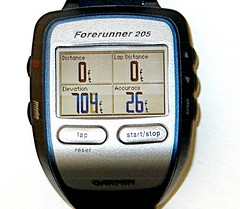Garmin Forerunner 205 GPS Tips
The main reason I like my new Garmin Forerunner 205 so much is because it is definitely more accurate than the my old Forerunner 201 (or 301 for that matter). No more weak GPS signals!
However, just because it is more accurate does not mean it does not have some GPS idiosyncrasies. On various forums, I've seen new users complaining about poor signal strength and/or a hard time acquiring satellites.
I believe most of the time these problems can be attributed to the 205's high sensitivity SiRFstarIII GPS chip. It seems the chip is so sensitive in the 205 (and 305) that it has a hard time acquiring satellites if the device is not in a steady position.
I know this all sounds counter intuitive, because the device was made for measuring distance, pace, etc, while in motion, but the new Forerunners have to be locked into a strong signal for them to work well. And once locked in they stay that way for the most part.
So far I have never had a weak or lost signal with my 205 (knock on wood), and below are some of my tips to make sure you can get the best performance possible out of your 205 or 305. Of course, YMMV (your mileage may vary):
- Power On Device in a Stationary Position: This is very important. Before a run, I place my watch on the ground in my backyard with a open view of the sky and then power on the device. I then go into my garage to put my running shoes on. After a few minutes it usually has acquired enough satellites and is ready for use, so I go out to get my watch and put it on my wrist.
- Customize a Screen with the GPS Accuracy Data Field: The GPS Accuracy data field is one of my favorite new features of the 205. The photo above is what my customized Running screen looks like. The bottom right corner shows the current GPS Accuracy in feet. The lower the better. So a good signal in my neck of the woods is in the 15-30 foot range. I always make sure it is in this range before I start my run. I then check the Accuracy occasionally throughout the run to see what kind of signal I'm getting. The numbers will fluctuate up and down but will usually stay in this range.
- Rinse and Repeat if Necessary: Every once in awhile during a run, the GPS Accuracy will get weaker and shoot up into the 40-50 feet range or higher, and one time it went to 70-80 ft. In those cases, when I come to a stop during the run (i.e. stoplight, water fountain, etc), I'll try to stand as still as possible, hold the 205 away from my body and point the antenna skyward. I also might slowly turn my body to face the 205 in a southwesterly direction (that's the direction my DirecTV satellite dish faces). Usually in less than a minute, the GPS Accuracy will improve and go back to the 15-30 foot range and I'll re-commence my run.
- Make Sure Your Device Software is Up to Date: One of nice things about the Forerunner 205/305 is Garmin is continually fixing things and adding enhancements via software updates. The latest software is version 2.40. Garmin also offers the WebUpdater software app for your PC to make updating the 205/305 an easier process. Just put the device in the USB cradle, launch WebUpdater, and it will find the most appropriate update from the Garmin web site and perform the update. Here are links to the latest versions:
- Garmin WebUpdater 2.3.2 (March 20, 2006)
- Garmin Forerunner 205 Software Update to version 2.40
- Garmin Forerunner 305 Software Update to version 2.40
Technorati Tags: Garmin, GPS, Global Positioning System, Satellite Navigation, Forerunner, MotionBased, SportTracks


<< Home